TarraWarra Museum of Art to host host major exhibition surveying 50 years of Arts Project Australia (APA)
For 50 years Melbourne’s APA studio has championed artists who experience the world differently, forging for artists like Alan Constable a place where their work is ‘interpreted, understood and critiqued’ in the same way as their peers.
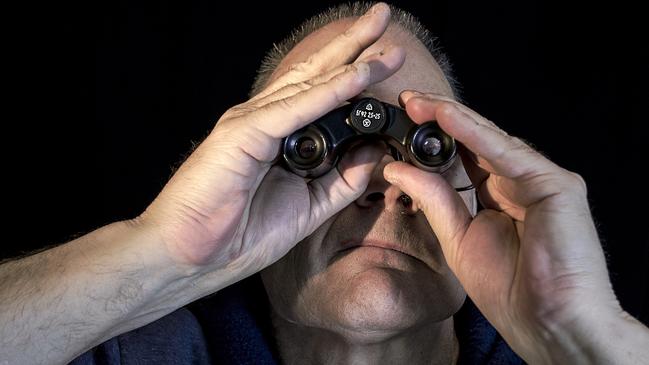
The taxi driver who dropped Alan Constable in front of the wrong building in the Melbourne suburb of Northcote in 1991 had no idea of the gift he was giving the contemporary art world. Instead of delivering Constable to the building where he worked as a cleaner, the driver dropped him in the lap of Arts Project Australia (APA), a studio that supports artists living with intellectual disabilities. While staff tried to work out how to help Constable get to his destination, they placed some art materials in front of him. What they saw when they returned convinced them to start negotiations with the cleaning company to modify Constable’s roster; it was not easy – he was their best cleaner – to allow him some days to attend the centre as a “studio artist”.
These days Constable is best known for his prolific output of glazed earthenware sculptures of cameras, and is one of 150 studio artists who attend APA every week. They work across a range of art practices from painting, drawing and ceramics, through to animation, digital art, stop-motion and zine-making, and are mentored by working artists to set career goals and try new mediums.
It’s not an art school, and it’s not an art therapy centre either.
“It has always been about supporting professional artists to work as artists,” APA director Liz Nowell says. Nowell, who has recently been appointed to the role, tells me that her background was very much in contemporary art “with a capital C and a capital A” (she ran the Institute of Modern Art in Brisbane and Adelaide Contemporary Experimental). “Most artists have fairly precarious employment. And this includes the artists at Arts Project, who are essentially freelancers. But the way we see it is that we are supporting 150 microbusinesses. They are employed as artists and we act as their agents. We sell their work, we help get their fees and act as a conduit between them and their employment income as contemporary artists.”
When I visit the two-storey warehouse on a sunny morning in late October, the high-ceilinged studio is flooded with natural light filtering in through a wall of large windows. The shelves are stacked with well-organised art supplies, the walls are lined with vibrant works, and a library crammed with art books connects two of the studio spaces. There are about 30 artists working, some silently engaged, others chatting animatedly. There’s a productive hum in the air that matches the pump of New Order’s Blue Monday, which is playing at a low volume. While I’ve visited many communal art spaces, I’m struck by how harmoniously the artists here are working. They share tables, and operate almost like one organism. At one table artist Bronwyn Hack is working on a tapestry. Her work is often inspired by body parts and bones; the one I see is a medley of pink, purple and red, the curvaceous lines unfolding into a representation of female genitalia.
“It can be really zany here,” artist Mark Smith says, describing an average day at the centre. “The variety of people make it unlike going to a factory or an office. Everyone’s doing their own work with their own ideas, it’s a major melting pot of creativity. When you’re in a creative atmosphere your mind automatically joins in. And then it goes off in all different creative directions.”
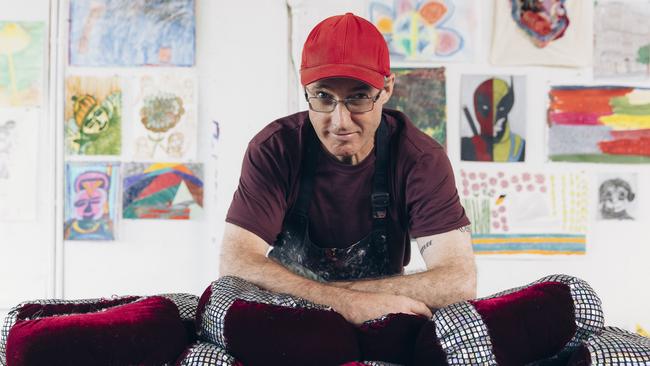
Smith tells me he feels different to the other artists at the centre, but not in a negative way. “I haven’t always been like this,” he says. In 1995 he was in a car accident that left him in a coma for four days. Neurologists told him he would never walk again. “That just made me more determined.” Smith is able to walk, but he lives with intention tremors that make movement difficult. He shows me how hard it is for him to touch his hands together. Incredibly, with the help of some tools, he is able to thread a needle to hand-stitch his soft sculptures.
When painter Georgia Szmerling walks in she’s wearing a puffer jacket emblazoned with the bright green and blue strokes of her paintings inspired by the natural world. I recognise it as one of the pieces from the centre’s 2021 collaboration with Australian fashion label Gorman. Szmerling tells me she still sees “people walking around wearing my work on their clothes.” And it makes her proud.
“When an artist starts at Arts Project there might be a high level of facilitation or experimentation so that they can start exploring,” Nowell says. “A big part of everything we do is about making sure the artists have autonomy and agency. We are led by the artist, and guided by what they want to explore and do in their work. But we also have artists who have been coming here for 40 years and are very clear about what they want to make and what they want to do.”
She mentions artist Terry Williams, who comes to the centre five days a week and is in what she calls “extended practice”, working on his distinctive soft sculptures using stuffed fabrics. “He’s been coming here for at least 30 years, and sits here every day making his work. Our staff will go to the fabric shop with him … You often see him dragging his suitcase around Northcote and it’s always full of fabric scraps.”
I see Williams sitting in the chair that has come to be known as Terry’s Chair, quietly sewing one of his rough-hewn soft sculptures that are usually inspired by objects from everyday life like helmets and bicycles. His work is held in London’s Museum of Everything, at the National Gallery of Victoria, and in private collections around the world. In 2015 he had a sold-out show at White Columns gallery in New York. As Williams is almost entirely non-verbal, we don’t interact.
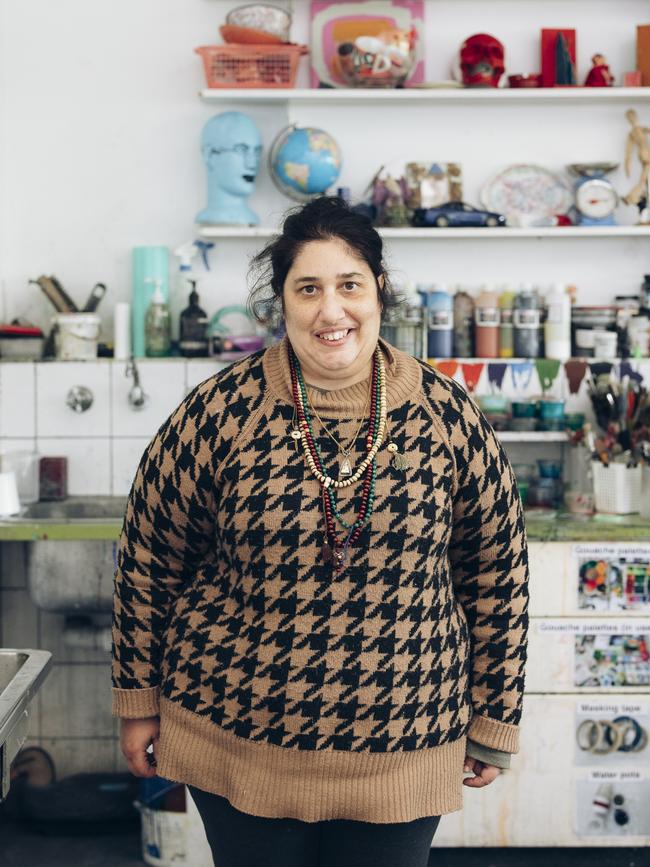
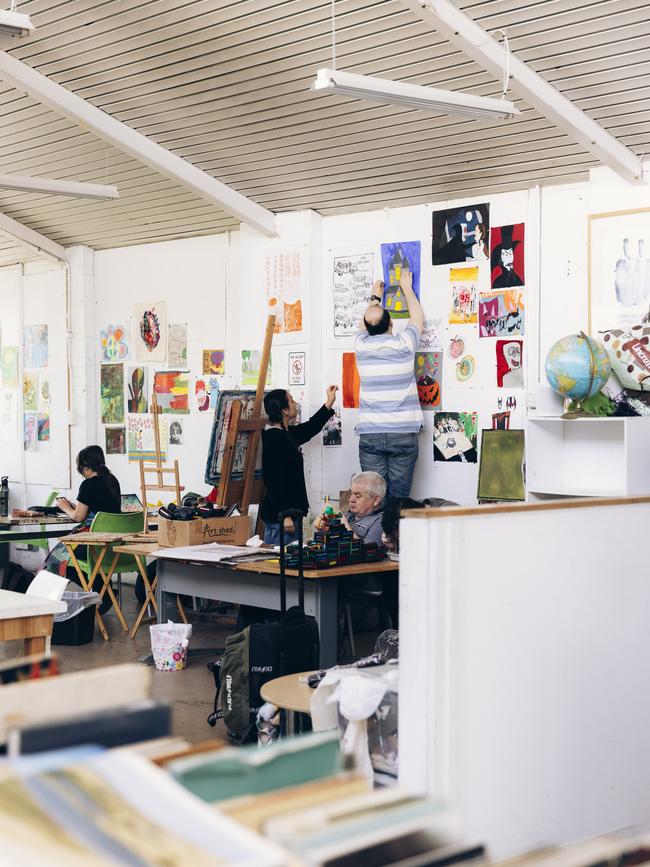
One room has been devoted to Williams’ work in Intimate Imaginaries, the first major exhibition surveying the work of APA artists, at TarraWarra Museum of Art in Healesville, Victoria. The exhibition, curated by Anthony Fitzpatrick, features the work of 12 studio artists and coincides with the 50-year anniversary of the centre. Included in the collection is a life-size self-portrait of the artist seated in Terry’s Chair. It brings to mind the work of Claes Oldenburg, who also made soft sculptures of everyday objects, but Williams leaves evidence of his process – strings fall from the edges, and stuffing spills out like innards.
The artists tell me they are excited about the upcoming show. Mark Smith’s new commissioned work hangs in the foyer and spells out the name of the exhibition in letters that span 4.5m wide. Lisa Reid, who was described by Pulitzer Prize-winning New York magazineart critic Jerry Saltz as a “strong voice of art”, drew on memories of her childhood to create a detailed ceramic sculpture of her mother’s 1971 Elna sewing machine. “Mum made matching blue dresses for me and my sister on this machine,” Reid says. When I ask how she felt as she worked on recreating it as a sculpture – it took over eight months and includes bobbins, scissors, a pedal and other intricacies – she replies with one word. “Happy.”
Alan Constable’s fateful taxi journey in the early 1990s makes me think of the famous tale of American artist Henry Darger. In 1972, Darger, who worked as a hospital janitor for most of his life, left the room he had rented for over four decades to move into a nursing home. Upon leaving, his landlord discovered Darger’s life’s work which included a six-volume weather journal, a 5,000-page autobiography, his now-famous 15,000-page novel The Story of the Vivian Girls, and several hundred drawings and paintings. After his death in 1973, Darger, whose work is now held by MoMA among other institutions, became canonised as the patron saint of Outsider Art.
It’s a term that evolved from Art Brut (translated as “raw art”), coined by French artist Jean Dubuffet in 1945 to describe naive art, or art that was made by artists outside of the conventions of traditional training. Dubuffet’s large collection is held in La Collection de l’Art Brut in the Swiss city of Lausanne. The term Outsider Art was coined by English art historian Roger Cardinal in 1972.
When I see Williams’ soft sculptures, and Constable’s cameras, I interpret them as examples of the genre. But as I speak to more people about the centre I note the marked absence of any mention of the term. It makes me ask, if the aim of the APA is to embed the work of neurodivergent artists into the mainstream contemporary art world, is the term Outsider Artist now considered a pejorative?
“It’s an interesting one …” Nowell says. “In America, that’s still very much a term you use, but certainly in Australia, and in the UK, it’s not considered appropriate any more. I think that for some people being an outsider is a positive thing, and it’s a source of strength. But I think it’s time the outside was at the centre. It’s time to put the outsiders on the inside. So we try to stay away from that language.”
Fitzpatrick’s involvement with the centre stretches over a decade. He’s been connected as a visitor, as a guest speaker at openings, and as a curator. In 2014 he presented a paper at Contemporary Outsider Art: The Global Context, a conference organised by APA in collaboration with the University of Melbourne. He agrees that the term can contribute to “the social and cultural marginalisation of the individual”.
“The notion that Outsider Art can be seen as without traditional skill, historical context or external influences has been widely challenged. While [the term] Outsider Art is still commonly used, most conspicuously in the annual Outsider Art Fair in New York, the term has spread beyond its original intended meaning to become an all-pervasive category for any works produced beyond the boundaries of the conventional art industry. While some use the term as a convenient catch-all to encompass a wide range of unconventional artistic production, others have reappraised the label, finding it a highly problematic and anachronistic term.
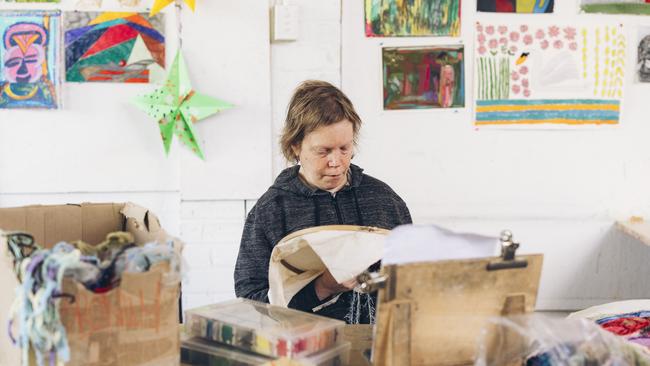
“It connotes a degree of sensationalism that appeals to romanticised notions of a life lived outside the boundaries of social conventions whereby the artist’s biography and circumstances might overtly influence or, at times, overshadow the understanding or appreciation of their work.”
The question – Is it good art? Or is it good because of what the artist has had to overcome to make it? – is something I walked into the centre thinking about. And the work I see – Reid’s emotive sculptures that draw on childhood memories, Williams’ anthropomorphic sculpture of a stereo with a tape deck that looks like a gaping maw – is among the most moving and impressive work I have seen in a long time.
“The art needs to be seen as equal,” Nowell says. “And interpreted, understood and critiqued as equal. Institutions need to think about accessibility and inclusion in a way that is more than just about removing barriers. It’s actually about representation: that people go to a state gallery or a national gallery and see people with disabilities reflected in the collections of those institutions, not just tacked on to the programming.”
But Nowell notes that in a studio of 150 artists there are bound to be a myriad of approaches to the issue. “All of our artists identify with their disability in very different ways,” she says. “Some want their work to be seen on the basis of the aesthetic experience and others are very proud of their disability and what they’ve had to overcome to be an artist, and want that to be part of the broader context of their work. Having worked previously in the First Nations art space, that conversation also exists there. I think about people like Tracey Moffatt, who has always wanted to be seen as an artist, not necessarily an Aboriginal artist. But there are plenty of artists that want to be seen as First Nations artists. It’s a constantly moving dialogue.”
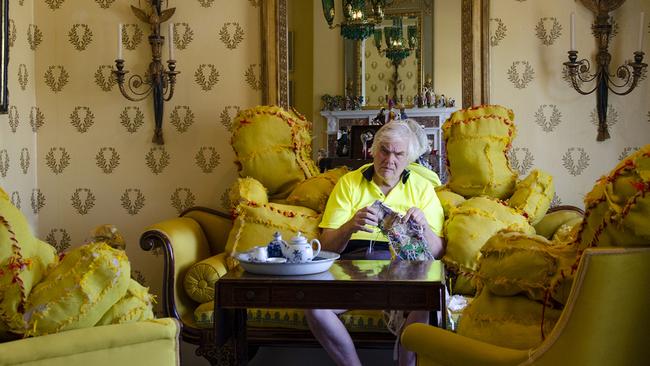
One artistic archetype that does seem to be prevalent at the centre is that of the obsessive type. Constable, for example, started making representations of cameras out of cardboard when he was a young boy; the impulse merged into a lifelong preoccupation that, fortuitously, became a vocation.
“I don’t think that anything could stop them making art,” Nowell says. “Even when we have a term break they are still working. But community and care has been critical to the success of the artists and the centre. I think the community we have here is the envy of the Melbourne art world. A lot of artists I’ve worked with outside of Arts Project have said, ‘My God, I would kill to be in a studio environment like that.’”
The origins of Arts Project Australia go backto 1974, when artist Myra Hilgendorf recognised the power of art as a vehicle for expression for her intellectually disabled daughter Johanna, who had limited language.
“She would go around collecting artwork and then mount touring shows that went across the country,” Nowell tells me.
Cheryl Daye, former director of APA, adds: “Being an artist herself, Myra was able to appreciate the ingenuity, spontaneity and originality of the works she and her colleagues collected from various day centres and institutions. By presenting professionally mounted exhibitions in mainstream galleries, the aim was to afford the artists the dignity of having their work taken seriously as a form of human expression and not as simply a recreational pastime. For it to be seen as art, and not as therapy.
“What was clear from these early endeavours was that the artists usually only had access to poor quality materials and limited opportunities to make art. This led us to envisage a community-based studio outside of the usual institutional settings with high quality materials and support from practising artists.”
In 1988 the studio found a home in a rat-infested former wrought-iron factory in Northcote. The current premises, a former shoe factory, was purchased in 2001 and has been the centre’s forever home since.
“It was rewarding; it was fun; it was also often difficult,” Daye writes in the book Fifty Years, released to coincide with the exhibition. “Everyone learned on the job and adapted as we grappled with fresh challenges, always responding to the needs of the artists.”
“And we’ve never really wavered from that,” Nowell says. These days the centre is staffed by “artist professionals” and volunteers. Studio artists pay to attend the program, which is an NDIS service provider and has additional funding channels through Creative Victoria and Creative Australia, artwork sales and private donors. In addition to its Northcote studio and streetfront gallery, APA also has a stand-alone exhibition space in Collingwood that exhibits seven shows per year in conjunction with some of the country’s leading curators. Many of the studio artists have exhibited around the world and are held in multiple public and private collections. In the 50 years since its inception, it has nurtured the careers of 550 working artists.
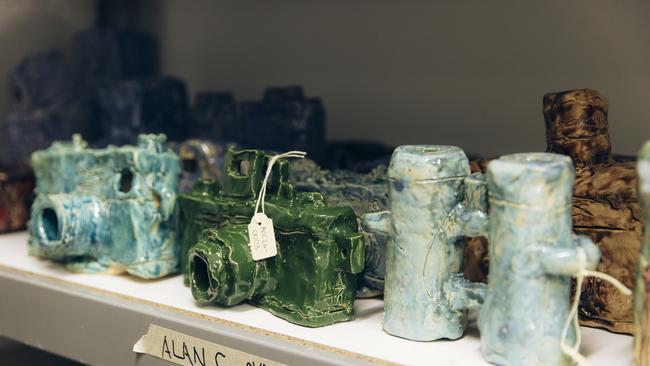
Mark Smith describes the staff and volunteers at the centre as like the “kerbs of the road that we, the artists, are on.”
They keep you on track? I ask.
“They are professionals,” he answers. “So when you bump up against kerb they can give you the best techniques and advice.”
Szmerling says it’s a fun place to be but also “a safe place”.
“I have a disability,” she tells me. “And this is a safe place for people with disabilities.”
Szmerling has painted a mural on the walls of TarraWarra inspired by the natural landscape. Working alongside her is artist Cathy Staughton, who has painted a self-portrait as Luna Park on the walls of the museum. “Cathy grew up opposite Luna Park [in St Kilda],” Fitzpatrick explains. “Her father was the local mayor, so it’s been part of her life since she was a girl. Over 40 years she has interwoven dream and nightmare-like imagery into these narratives. But sometimes it’s just for fun as well.”
Before I leave the centre I pop into the storeroom, which staff describe as the “candy store”. I can see why – it’s stacked floor-to-ceiling with a dizzying variety of ceramic works. I’m invited to handle, carefully, one of the cameras that Constable has made for the exhibition. Constable, who is legally blind and has only pinhole vision, includes a viewfinder in each of his cameras. I hold it up to my eye and look through it. It’s a moment in which I have a glimpse of what the world might be like through his lens. A snapshot we might never have seen had his taxi driver delivered him to the right address 40 years ago.
Intimate Imaginaries opens at TarraWarra Museum of Art on November 30

To join the conversation, please log in. Don't have an account? Register
Join the conversation, you are commenting as Logout